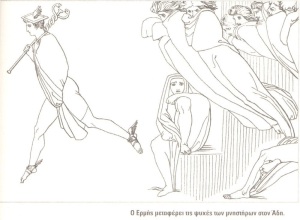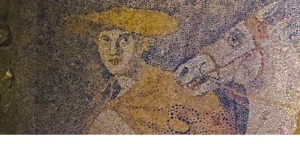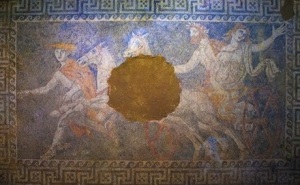AMPHIPOLIS CASE BY DR KRISTIS CHARAKIS

AMPHIPOLIS Case:
“Based on the Enormous Cenotaph”
(An interpretation among the many others for the mystery of the tomb)
By Dr Kristis Charakis,
Chairman of the Limassol Writers’ Association: “Vasilis Michaelides”
** ε **
Alexander the Great held Homeric Achilles as an idol. The epics of Homer were part of Alexander’s education. He could also be considered as a mystic of the creed “on the soul of the sacred” in Ancient Egypt, where he was worshiped as the son of Ra, and he even built the most magnificent city, Alexandria.
Our reference, “on the huge cenotaph” Amphipolis, is based on two possible assumptions:
– Alexander, as a mystic, having the conviction “on astral bodies” for himself and his soldiers, believed on the true return of the Soul to the great dwelling of Macedonia, place of their birth; this was his own Ithaca, and-
-Alexander, as an intelligent commander, gambling on a potential strategy “challenge”, directed the belief in the soldiers “on definite return with glory”, that possibly worked on the mentality of the Macedonians, because the Greeks considered even the burial of the dead, in foreign lands, as pointless, since the “return of Soul” born the “certainty of glory.”
These two assumptions are based on the beliefs of the ancients on the model of the description of the last rhapsody of Homer in Book 24, 1 to 13, where he leads the procession of the souls “Hermes the Psycopompus-the God responsible for carrying the souls of the dead people,”, and leads the souls “in the land of dreams”, where they would meet with serenity the souls of the heroes of Troy.
**ε**
[1] Meanwhile Cyllenian Hermes called forth the spirits of the wooers.
He held in his hands his wand, a fair wand of gold,
wherewith he lulls to sleep the eyes of whom he will,
while others again he wakens even out of slumber;
with this he roused and led the spirits, and they followed gibbering.
And as in the innermost recess of a wondrous cave bats flit about gibbering,
when one has fallen from off the rock from the chain
in which they cling to one another,
so these went with him gibbering, and Hermes,
the Helper, led them down the dank ways.
Past the streams of Oceanus they went,
past the rock Leucas, past the gates of the sun and the land of dreams,
and quickly came to the mead of asphodel,
where the spirits dwell, phantoms of men who have done with toils.
[15] Here they found the spirit of Achilles, son of Peleus,
and those of Patroclus, of peerless Antilochus, and of Aias,
who in comeliness and form was the goodliest of all the Danaans
after the peerless son of Peleus.
[SOURCE: Homer’s Ulysses, Book XXIV, 1-15,
Written 800 B.C.E, Translated by T. Murray]
**ε**
[1] Then Mercury of Cyllene summoned the ghosts of the suitors,
and in his hand he held the fair golden wand
with which he seals men’s eyes in sleep or wakes them just as he pleases;
with this he roused the ghosts and led them,
while they followed whining and gibbering behind him.
As bats fly squealing in the hollow of some great cave,
when one of them has fallen out of the cluster in which they hang,
even so did the ghosts whine and squeal
as Mercury the healer of sorrow led them down
into the dark abode of death.
When they had passed the waters of Oceanus and the rock Leucas,
they came to the gates of the sun and the land of dreams,
whereon they reached the meadow of asphodel
where dwell the souls and shadows of them that can labour no more.
[15] Here they found the ghost of Achilles son of Peleus,
with those of Patroclus, Antilochus, and Ajax,
who was the finest and handsomest man of all the Danaans
after the son of Peleus himself.
[SOURCE: Homer’s Ulysses,Book XXIV, 1-15,
Written 800 B.C.E, Translated by Samuel Butler]
**ε**
The visual comparison of different seasons causes an accord of feedbacks, where on one hand the Form of Hermes is extant from the perspective of the Odyssey, on the mosaics of Amphipolis, and on the other hand, the same form refers to a later drawing of “Soul Bearer Hermes” by John Flaxman (1795), which was engraved and printed by Tommaso Piroli.
The inspiration of an 18th century artist, illustrates the conjectural style of a painter who studied Greek language and literature. The artistic conception of about 320 BC., shows the expression of a painter, with a dominant religious devotion to ritual laurel-crowned glory; perhaps even while Alexander was alive. In both illustrations Hermes Kyllinios leads the procession.
**ε**
Apollo to Hermes: “[…] and there in the underworld
Hades, to have you the only angel;
while not accepting gifts, he’ll offer you prize
not small, Argeiphontes (= Hermes the slayer of Argos), but very large”
[SOURCE: To Hermes ΙΙΙ, Homeric Hymns 631-634, Τranslated by Kristis Charakis]
The possible explanation “for a large cenotaph” at Amphipolis, that hosts the Souls of the Macedonians and other Greeks, is based on the so far known revelations:
– The mosaic at Amphipolis, with the representation of Hermes, leading in front by the same reasoning, a laurel-crowned Macedonian,
– The lion of Amphipolis which irresistibly symbolizes, according to Professor D. Lazaridis and others, a monument of military glory and act, and
– The Caryatids, in the prototype of the monumental kore (1) of Acropolis, which extends the “memorial” towards Sterea as well.

Engrave by John Flaxman, 1795
The mosaic in Amphipolis
The entire complex, as a construction, focuses on an era between 320-250, where, it was either, built about 320 B.C., as a huge monument of glory, that hosts the souls of Macedonian and Greek soldiers, before the death of Alexander (323B.C.), by order of Alexander the Great; or it was built, between 323-250 B.C., when the Hellenistic civilization was actually inaugurated in the known world. In both cases, it should be associated with a temple, where the heroes will be honoured with sacrifices.
A similar offer of Alexander to the dead Hephaistion is noted, when “official envoys of Ammon, were sent to ask God what honour did Alexander had to offer to Hephaestion [Arrian, Alexander Anabasis (2) Book 7 XXIII 6]. Alexander ordered, by letter, to build a monument in honour of Hephaestion in Alexandria of Egypt and in the city and the island of Faro [Arrian, Alexander Anabasis Book7 XXIII 7].
If we accept the hypothesis “on the huge cenotaph”, constructed while Alexander was alive, that is, at the behest of Alexander the Great, this explains why the Form, on the mosaic is not that of Alexander himself. Perhaps one of the most recent major loss of a Macedonian, was, for Alexander, that of the Avreas. The bravery of the Macedonian officer, killed by an arrow in the face, fighting close to Alexander, who was himself wounded, within the walls of Malli Indians (3) [Arian, Alexander Anabasis Book VI ‘X 1], was a hero model, and a symbol “return of the glory of souls”. So, among the many interpretations of the mystery of the tomb, the probability of an illustrated laurel-crowned Form was that of this man, or some other Macedonian, who symbolically covered the ENTIRITY of the brave men of Alexander’s Anabasis.
(1) By definition, Kore (maiden) refers to statues depicting female figures, always of a young age.
(2) The Greek term “anabasis” referred to an expedition from a coastline into the interior of a country. A literal translation would be The Expedition of Alexander.
(3) The Mallian Campaign was conducted by Alexander the Great from November 326 to February 325 BC, against the Malli of the eastern Punjap


Leave a Reply